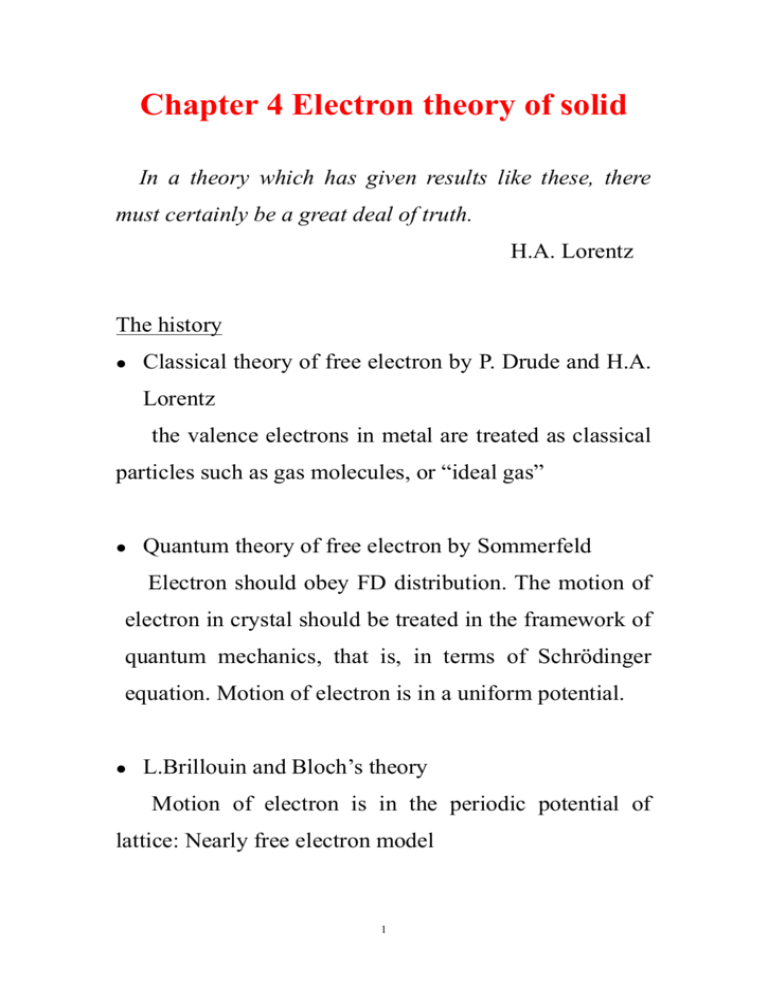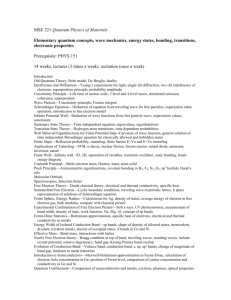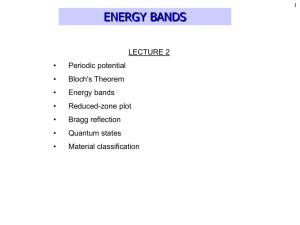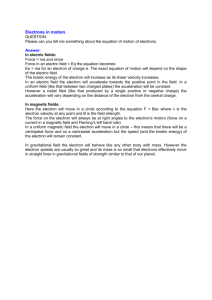Chapter 4 Electron theory of solid
advertisement

Chapter 4 Electron theory of solid In a theory which has given results like these, there must certainly be a great deal of truth. H.A. Lorentz The history Classical theory of free electron by P. Drude and H.A. Lorentz the valence electrons in metal are treated as classical particles such as gas molecules, or “ideal gas” Quantum theory of free electron by Sommerfeld Electron should obey FD distribution. The motion of electron in crystal should be treated in the framework of quantum mechanics, that is, in terms of Schrödinger equation. Motion of electron is in a uniform potential. L.Brillouin and Bloch’s theory Motion of electron is in the periodic potential of lattice: Nearly free electron model 1 §4.1 Energy state of electron gas 1. Sommerfeld model Quantum free electron gas, no-interaction, obeys FD statistics. 2. Free electron gas in a 3D box (1) The potential box (infinite potential well) V ( x, y, z ) 0, 0 x, y, z L V ( x, y, z ) , x, y, z L (2) Schrödinger equation 2m 2 E 0 (inside the box) 2 (3) Solution Separation of variables: ( x, y, z ) 1 ( x ) 2 ( y ) 3 ( z ) Periodic boundary conditions: ( x L, y, z ) ( x, y, z ) ( x, y L, z ) ( x, y, z ) ( x, y , z L) ( x, y , z ) 2 2 2 k 1 E (r ) e , 2m V 2 2 2 kx nx , k y ny , kz nz L L L ik r 3. State in k space (1) k space k k x i k y j k z k (2) The density of representative points in k space: V (2 ) 3 4. Density of State and equi-energy surface (1) The DOS g E dZ dE (2) The equi-energy surface within free electron approximation A sphere with radius g ( E ) 4Vc ( k 2mE 2m 3 / 2 1 / 2 ) E 2 3 §4.2 Fermi energy of electron gas 1. Fermi distribution and Fermi level F N V Fermi energy E F 1 f E E E k T F B e 1 T 0K: f ( E ) 1, E EF 0 f ( E ) 0, E EF 0 f ( E ) 1, E E F several k BT T 0K: f ( E ) 1 / 2, E E F f ( E ) 0, E E F several k BT EF is not fixed, it depends on temperature T . Fermi temperature TF E F / k B Fermi wave vector k F 2mE F / 2. Fermi energy at T 0 K (1) the idea N f ( Ei ) i (2) the derivation N E F0 0 f ( E ) g ( E )dE → (3) the average energy E 3EF / 5 0 4 E F0 h 2 3n 2 / 3 ( ) 2m 8 3. Fermi energy at T 0 K N 0 EF E F0 2 3 / 2 f f ( E ) g ( E )dE C E ( )dE 3 0 E 2 k BT 2 ( 0 ) 1 12 EF 5 → §4.3 Heat capacity of the electron gas in metal 1. Introduction Why the heat capacity of electron is so small? — Only those near the Fermi surface are counted 2. The derivation of CVe 2 2 3 0 5 2 k BT 5 2 k BT Ee EF 1 0 E0 1 0 5 12 EF 12 EF Cve 2 k BT Ee kB 0 T 2 EF V 6 §4.4 Bloch wave 1. Introduction The electrons in a crystal is not absolutely free, they are confined in a periodic potential. To solve the many-body problem: (1) adiabatic approximation (2) single electron approximation (3) periodic field approximation 2. General features of electron motion in a periodic potential using Bloch wave to describe has energy band structure 3. Bloch wave (1) Bloch theorem e uk ( r ) , uk ( r ) uk ( r Rl ) ik Rl k ( r Rl ) e k ( r ) k ( r ) or ik r 7 (2) proof of Bloch theorem Using the translational symmetry of crystals: [ Hˆ , TˆRl ] 0 (3) The physical meaning of Bloch functions Free motion of electrons as well as confinement by periodic potential. An illustration of Bloch wave 4. The Brillouin zone the reduced Brillouin zone (1st Brillouine zone): The region enclosed by the perpendicular bisector of lines (planes) connecting the nearest reciprocal lattice points. k 1b1 2 b2 3b3 j lj Nj , Nj 2 lj Nj 2 8 two typical examples showing electron motions in 1D periodic field: Kronig-Penney model Nearly free electron model 9 §4.5 Kronig-Penney model 1. Introduction a simplified model proposed by Kronig and Penney in 1930 which can exhibit energy band structures of electrons in periodic potential. the problem can be strictly solved V(x) V0 -a -b 0 c a x a=b+c 2. Single-electron Schrödinger equation d 2 2m ( E V ) 0 ,V ( x) V ( x na) dx2 2 ( x ) eikxu( x ) 3. Solutions in different regions in the potential well: 0 x c V 0 10 let 2 2mE 2 in the 2 potential barrier: b x 0 V V0 let 2m(V0 E ) 2 4. The constants A0 , B0 , C0 , D0 at x 0, c , u and du should be continuous in both dx regions 2 2 sinh b sin c cosh b cos c cos ka 2 5. Simplifications and discussions Suppose V0 and b 0 , but V0 b is limited. 2ab p , then we have 2 sin a P cos a cos ka a Let lim P sin a cos a a -4 - -3 -2 +1 0 -1 P=3/2 11 2 3 4 a Energy band structure: E ~ k Some general features: (1)energy bands and forbidden bands (2) E ~ k is even function (3)location of forbidden bands (4)the width of energy bands (5)periodicity (6)number of electrons 6. Scheme of energy band structures ( Page 146 of textbook) extended zone scheme: different bands are drawn in different zone 12 periodic zone scheme: every band is drawn in every zone reduced zone scheme: all bands are drawn in the 1st zone 13 §4.6 Nearly free electron non-degenerate perturbation model: 1. The idea of perturbation theory The band structure of a crystal can often be explained by the nearly free electron model for which the band electrons are treated as perturbed only weakly by the periodic potential of the ion cores. This model answers almost all the qualitative questions about the behavior of electrons in metals. 2. Single-electron Schrödinger equation 2 2 V ( x ) E ,V ( x) V ( x na) 2 m V ( x ) V0 Vn e ' i 2 nx a n 2 i 2 ' ˆ ˆ ˆ H H0 H ' ( V0 ) Vn e 2m n 2 nx a Using non-degenerate perturbation theory: 2 Ek Ek0 Ek( 2 ) 2m Vn 2k 2 ' 2 2 2m n 2k 2 2 (k n) a 14 k k0 k(1) 2 i nx * a 2mVn e 1 ikx e 1 ' 2 2 L 2 2 2 n k (k n) a 3. Failure of non-degenerate perturbation theory non-degenerate perturbation theory : zero-order energy is non-degenerate Ek0 Ek0' (1)at the zone boundary k Kn n 2 n n ,k' k , Ek0 Ek0' 2 a a a Ek( 2 ) , k(1) (2)near the zone boundary k Kn K (1 ) , k ' n (1 ) 2 2 E k0 E k0' Failure of non-degenerate perturbation theory! Should consider degenerate perturbation theory. 15 §4.7 Nearly free electron model: degenerate perturbation 1. Energy states at or near the zone boundary k Kn K (1 ) , k ' n (1 ) 2 2 (1) zero-order wavefunction 0 A k0 B k0' A 1 ikx 1 ik ' x e B e L L (2) the energy 2 E Tn (1 2 ) Vn 4Tn2 2 K 2 K n 2 2 n 2 Tn ( ) ( ) (kinetic energy for k n ) 2 2m 2 2m a (3) discussions 0 (at zone boundary) k K n K n n ,k' n 2 a 2 a E Tn Vn , E Tn Vn , forbidden bands at zone boundary: E g 2Vn 0 (near zone boundary) Ek0 Ek0' Vn Ek0 Ek0' Vn 2. General features of dispersion relations ( E ~ k ) 16 §4.8 Velocity and acceleration of electron motion in crystal 1. The motivation The response of electron in crystal to external electromagnetic fields can be regarded as a classical free electron with effective mass m * 2. Average velocity of electron motion 1 v ( k ) k E ( k ) 3. The variation of state k in external electromagnetic fields dk e[ v B] dt quasi-momentum: k 4. acceleration and effective mass (1) 1D case dv 1 2 E 2 2 F , F m*a dt k 1 1 2E m* 2 k 2 17 effective mass m * : includes both the inertial mass and the effect of periodic potential effective mass of electrons at the bottom and top of energy band: k Kn K (1 ) k0 k , k ' n (1 ) k0 k 2 2 ( k0 Kn K , k n k0 ) 2 2 2 2 E E min * ( k) 2mbottom * at the bottom: mbottom m 0 2 k02 1 m Vn 2 2 E Emax * ( k) 2mtop * at the top: mtop m 0 2 k02 1 m Vn (2) 3D case 2 1 E v 2 F k k 1 1 reciprocal effective mass tensor: 2 m * 18 2E k k it can be diagonalized if properly choosing axis: 1 m* m* (3) summary m * is related to energy band structure m * is related to symmetries in crystal m * can be positive or negative dv 1 dk F , F dt m * dt 19 §4.9 Conductor, insulator semiconductor and 1. Introduction Although there are many electrons in solids, some of them have good electric conductivity, some are less and others do not have any conductivity. 2. The classification of energy bands filled bands: all the 2 N states are occupied by electrons empty bands: no state in the 2 N states conduction band : the 2 N states are partially occupied 3. The conducting behaviors of energy bands (1) when there is no external field ( 0 ) all the three kinds of energy bands remains neutral, no current (2) when an external field is applied ( 0 ) electrons in filled bands: no current electrons in unfilled bands: induce current 20 4. The band structures of conductor, semiconductor and insulator In addition to a series of occupied bands in a conductor, there are partially occupied energy bands which can induce current flow. These partially occupied bands are the so-called conduction bands. In a non-conductor, a series of lower energy bands are exactly occupied by electrons and the higher energy bands are all empty. Since no current can be caused by filled bands, it’s not conducting although there are many electrons. Both semiconductor and insulator belong to non-conductor. The difference is that a semiconductor has small band gap (< 2eV) while an insulator has a large gap. 5. Some examples alkali metals alkaline earth metals elements in column IV 21 6. Nearly filled bands and holes (1) The idea j ev (k ) when a k state is empty, the total current of energy bands is as if caused by a positive charge e with velocity the same as that of electron in the k state. Such empty state is called hole. (2) Hole motion in electromagnetic fields dv e * ( v B ) dt me let mh* me* 0 dv e * ( v B ) dt mh The hole can be regarded as a particle with positive effective mass m h* and positive charge e . (3) the momentum and energy of holes It is generally recognized that holes and electrons 1 obey the same classical laws by v (k ) k E (k ) and 1 dk F dt the quasi-momentum: kh ke the energy: E (kh ) E (ke ) 22 Homework P136 1,2 P164 4,7 Addition:在低温下,金属钾的摩尔热容量的实验结果 可以写成 c (2.08 T 2.57 T 3 ) 毫焦/摩尔·开 若1摩尔钾有 N 61023 个电子,试求钾的费米温度和 德拜温度。 23








